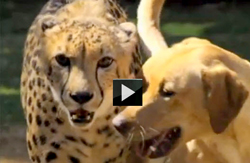These skillfully shot videos reveal fascinating, touching and quite unlikely cross-species friendships in the animal kingdom.
Despite the odds, there are countless stories of the most unlikely cross-species relationships imaginable: a goat guiding a blind horse; a doe who regularly visits her Great Dane surrogate mother; a juvenile gibbon choosing to live with a family of capuchins, and so on. Instincts gone awry?

The subject has mystified scientists for years. Now, NATURE investigates why animals form these special bonds. Informed by the observations of caregivers and noted scientists Temple
Grandin and Marc Bekoff, the film explores what these relationships suggest about the nature of animal emotions. The full videos are at the NATURE site. Funny dog video of Labrador playing with cougar-showing-animal-odd-couples frinedship
Video of Animal Odd Couples – fawn & dog
After being abandoned by her mother, a baby fawn, Pippin, was adopted by a Great Dane, Kate, and they have been best friends ever since. Kate’s owner Isobel Springett describes the uniqueness of their relationship: “When they greet each other, I’ve never seen anything like it. It’s not a deer greeting a deer. It’s not a dog greeting a dog. It’s definitely something that they have between the two of them.”
Video of Animal Odd Couples – goose & tortoise
At Busch Gardens, a 45-year-old female Aldabra tortoise was chosen by an unlikely suitor: a male Pacific Brant goose. The unusual pair has been together for 4 years. Brant geese mate for life, and it seems that this friendship is in for the long haul.
Video of Animal Odd Couples – studying the emotional lives of animals
In this video, Dr. Marc Bekoff, former Professor of Ecology and Evolutionary Biology at the University of Colorado featured in Animal Odd Couples, on the scientific study of animal emotions, animal friendships, and the elements of the brain that allow for such bonds to form.
Animal Odd Couples – The Emotional Lives of Animals
Chapter One – The Case for Animal Emotions and Why They Matter
Many animals display their feelings openly, publicly, for anyone to see. And when we pay attention, what we see outside tells us lots about what’s happening inside an individual’s head and heart. As we’ll find, careful scientific research is validating what we intuitively understand: that animals feel, and their emotions areas important to them as ours are to us.
Video of Animal Odd Couples – the benefits of friendship
Primatologist and evolutionary biologist Dr. Lauren Brent discusses her research on nonhuman primate social behavior, and what it shows about the benefits of friendship.
The Case for Animal Emotions and Why They Matter – by Marc Bekoff
Were these birds thinking about what they were doing? Were they showing magpie respect for their friend? Of were they merely acting as if they cared? Were they just animal automatons? I feel comfortable answering these questions, in order: yes, yes, no, no. Rod was astounded by how deliberate the birds were. He asked me if this was normal magpie behavior, and I told him that I’d never seen anything like this before and hadn’t read any accounts of grieving magpies. We can’t know what they were actually thinking of feeling, but reading their actions there’s no reason not to believe these birds were saying a magpie farewell to their friend.
Despite the more than three decades I’ve spent studying animal species, I never cease learning from the individuals I encounter. Red foxes live near my mountain home outside of Boulder, Colorado. As I stare into the eyes of a red fox sitting by my study and watching me type, or as I observe red fox pups playing with one another or a female red fox burying her mate, I can’t help but reflect deeply on what it’s like to be these individuals sharing my hillside. Many animals live on the surrounding land – coyotes, mountain lions, porcupines, raccoons, black bears, a wide variety of birds, and lizards, along with many dogs and cats. Through the years, they’ve been my friends and teachers.
